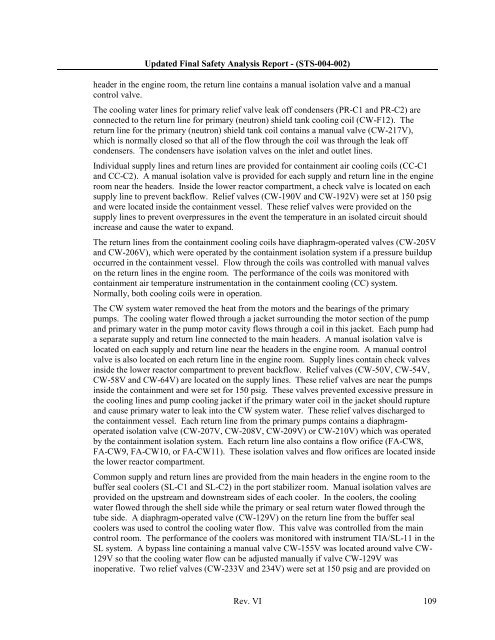10 CFR 50.71(e) - Maritime Administration - U.S. Department of ...
10 CFR 50.71(e) - Maritime Administration - U.S. Department of ...
10 CFR 50.71(e) - Maritime Administration - U.S. Department of ...
Create successful ePaper yourself
Turn your PDF publications into a flip-book with our unique Google optimized e-Paper software.
Updated Final Safety Analysis Report - (STS-004-002)header in the engine room, the return line contains a manual isolation valve and a manualcontrol valve.The cooling water lines for primary relief valve leak <strong>of</strong>f condensers (PR-C1 and PR-C2) areconnected to the return line for primary (neutron) shield tank cooling coil (CW-F12). Thereturn line for the primary (neutron) shield tank coil contains a manual valve (CW-217V),which is normally closed so that all <strong>of</strong> the flow through the coil was through the leak <strong>of</strong>fcondensers. The condensers have isolation valves on the inlet and outlet lines.Individual supply lines and return lines are provided for containment air cooling coils (CC-C1and CC-C2). A manual isolation valve is provided for each supply and return line in the engineroom near the headers. Inside the lower reactor compartment, a check valve is located on eachsupply line to prevent backflow. Relief valves (CW-190V and CW-192V) were set at 150 psigand were located inside the containment vessel. These relief valves were provided on thesupply lines to prevent overpressures in the event the temperature in an isolated circuit shouldincrease and cause the water to expand.The return lines from the containment cooling coils have diaphragm-operated valves (CW-205Vand CW-206V), which were operated by the containment isolation system if a pressure buildupoccurred in the containment vessel. Flow through the coils was controlled with manual valveson the return lines in the engine room. The performance <strong>of</strong> the coils was monitored withcontainment air temperature instrumentation in the containment cooling (CC) system.Normally, both cooling coils were in operation.The CW system water removed the heat from the motors and the bearings <strong>of</strong> the primarypumps. The cooling water flowed through a jacket surrounding the motor section <strong>of</strong> the pumpand primary water in the pump motor cavity flows through a coil in this jacket. Each pump hada separate supply and return line connected to the main headers. A manual isolation valve islocated on each supply and return line near the headers in the engine room. A manual controlvalve is also located on each return line in the engine room. Supply lines contain check valvesinside the lower reactor compartment to prevent backflow. Relief valves (CW-50V, CW-54V,CW-58V and CW-64V) are located on the supply lines. These relief valves are near the pumpsinside the containment and were set for 150 psig. These valves prevented excessive pressure inthe cooling lines and pump cooling jacket if the primary water coil in the jacket should ruptureand cause primary water to leak into the CW system water. These relief valves discharged tothe containment vessel. Each return line from the primary pumps contains a diaphragmoperatedisolation valve (CW-207V, CW-208V, CW-209V) or CW-2<strong>10</strong>V) which was operatedby the containment isolation system. Each return line also contains a flow orifice (FA-CW8,FA-CW9, FA-CW<strong>10</strong>, or FA-CW11). These isolation valves and flow orifices are located insidethe lower reactor compartment.Common supply and return lines are provided from the main headers in the engine room to thebuffer seal coolers (SL-C1 and SL-C2) in the port stabilizer room. Manual isolation valves areprovided on the upstream and downstream sides <strong>of</strong> each cooler. In the coolers, the coolingwater flowed through the shell side while the primary or seal return water flowed through thetube side. A diaphragm-operated valve (CW-129V) on the return line from the buffer sealcoolers was used to control the cooling water flow. This valve was controlled from the maincontrol room. The performance <strong>of</strong> the coolers was monitored with instrument TIA/SL-11 in theSL system. A bypass line containing a manual valve CW-155V was located around valve CW-129V so that the cooling water flow can be adjusted manually if valve CW-129V wasinoperative. Two relief valves (CW-233V and 234V) were set at 150 psig and are provided onRev. VI <strong>10</strong>9
















